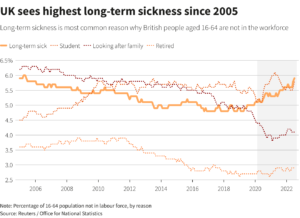UK long-term sickness rate rises to highest since 2005
UK long-term sickness rate rises to highest since 2005
By David Milliken
LONDON, Sept 13 (Reuters) – The proportion of Britain’s workforce too sick to work has jumped to its highest since 2005, which economists say is likely due to a mix of long COVID and greater difficulty in accessing health care since the start of the pandemic.
A record 2.464 million people aged 16-64 gave long-term sickness as the reason why they were neither working nor seeking work during the three months to July, figures from the Office for National Statistics showed on Tuesday.
 This equates to 5.9% of the working-age population – the highest proportion since the three months to June 2005, and one which has accelerated over recent months.
This equates to 5.9% of the working-age population – the highest proportion since the three months to June 2005, and one which has accelerated over recent months.
Higher rates of long-term sickness and a broader rise in labour force inactivity – now its highest since 2017 – have become a growing concern for the Bank of England.
Central bankers fear slowing labor force growth will make it hard for the economy to keep up with demand, boosting inflation pressures and limiting Britain’s growth potential.
In absolute terms, the number of working-age people who are long-term sick and not in work has risen by 352,000 since the start of the pandemic and has increased by 127,000 since the three months to April.
PwC economist Jake Finney said this was “likely owing to a combination of long COVID and large NHS waiting lists”.
Some 2.0 million British people reported suffering from long COVID at the end of July, of whom 384,000 said their day-to-day activity was “limited a lot” by their symptoms, according to ONS data released this month.
A record 6.84 million people in England were waiting for hospital treatment in July, up from 4.24 million at the start of the pandemic in March 2020, according to analysis by the British Medical Association.
Our Standards: The Thomson Reuters Trust Principles.
Source: Reuters











